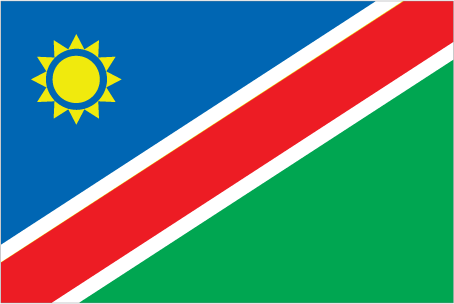To help inspire or plan your trip to Namibia, some of its major attractions
for travellers are shown below, including some of the best natural, historical, cultural and adventure sites in the country.
These include all of UNESCO World Heritage Sites for Namibia which represent the best
of the world's cultural and natural heritage.
Click on the icons below to focus on specific types of features
(click again to return to all).
|
|
|
|
|
|
|
|
|
|
|
|
 |
|---|---|---|---|---|---|---|---|---|---|---|---|
| Natural | History | Wildlife | Trekking | Cities | Religious Monument | Boat Journey | Rail Journey | Diving | Cultural | Adrenaline | UNESCO WHS |
| Etosha National Park | |
|---|---|
Etosha National Park is Namibia's premier wildlife sanctuary and one of the best game reserves in Africa, covering a huge 22,000 km². Its terrain is a mixture of bush and grassland centred around the huge, flat, dazzling white expanse of the Etosha Pan, a dried up former lake. Over 340 bird species and 100 mammal species are present in the park including all the major game and predators, as well as the rare and endangered black rhinoceros, black-faced impala, Hartmann’s mountain zebra and the tiny damara dik-dik. Etosha is renowned for its floodlit waterholes that allow you to view herds of animals drinking at night. | |
| Sossusvlei and Sesriem Canyon | |
|---|---|
The Namib-Naukluft Park, at almost 50,000 km², is the fourth largest nature conservation area in the world and contains the world's oldest desert, the Namib Desert. The sand dunes at Sossusvlei are its biggest attraction and one of the most evocative and beautiful sites in Africa. The dunes are deep red in colour and up to 300m high and the views of the surrounding desert are spectacular. Climbing up one of these immense dunes, especially at sunrise or sunset to witness the dramatic and changing colours, is one of the quintessential Africa experiences, while running and jumping down the steep sides provides an exhilarating and quick trip back to the bottom. The isolated Dead Vlei, hidden behind sand dunes, is even more dramatic - its 600 year old dead tree trunks lie in a white parched surface and contrast beautifully with the surrounding red dunes and bright blue skies. Nearby are the small but dramatic rock formations of the Sesriem Canyon gorge. UNESCO World Heritage Site: Namib Sand Sea | |
| Damaraland | |
|---|---|
The beautiful area of Damaraland contains some striking mountain scenery including that of Brandberg, Namibia's highest peak at 2573 metres, and Spitzkoppe, a distinctly shaped granite rock formation, 1728 metres high and referred to as the "Matterhorn of Africa". Both locations contain numerous examples of Bushmen rock art and are wonderful locations for camping under the African stars. | |
| Twyfelfontein | |
|---|---|
Twyfelfontein or /Ui-//aes contains over 2,500 rock engravings and paintings some of which date back over 6,000 years to the Stone Age. The engravings represent animals such as rhinoceros, elephant, giraffe and ostrich as well as human and animal footprints. UNESCO World Heritage Site: Twyfelfontein or /Ui-//aes | |
| Fish River Canyon | |
|---|---|
Fish River Canyon is the world's second largest canyon, a spectacular chasm 161km long, 27 km wide and 550 metres deep. The outer canyon was formed by tectonic activity and the inner canyon by erosion from the Fish River. There are breathtaking views from atop the escarpment edge and excellent hiking opportunities along and within the canyon. | |
| Swakopmund | |
|---|---|
Swakopmund is a delightful town founded by the Germans in 1892 and still retaining its original colonial influence. Surrounded by the desert and Atlantic Ocean, Swakopmund has many attractions including well preserved Art Nouveau buildings, museums detailing its history and marine life, excellent bars and restaurants as well as many shops selling Namibian souvenirs. Swakopmund has also become a centre for adrenaline activities which include sky diving, sand boarding and quad biking on the Namib dunes and horse or camel rides. More relaxing activities include hot air balloon rides or airplane flights over the desert, dolphin cruising and deep sea fishing. | |
| Waterberg Plateau National Park | |
|---|---|
The Waterberg Plateau is a flat-topped sandstone mountain that rises 200 metres over the surrounding plains and is 50 kilometres long and 16 kilometres wide. The plateau was the site of the decisive battle between the Herero and German colonial forces but today is a national park that is the home to many rare and endangered animals including leopard and roan and sable antelope. The park also has great hiking trails with spectacular views. | |
| Cheetah Park / Otjiwarongwe | |
|---|---|
Cheetah Park at Otjiwarongwe is a private farm dedicated to the conservation of the cheetah. Here you can see the cheetahs on the private reserve being fed on a game drive and also get up close and personal to the "domesticated" cheetahs for a great photo opportunity. | |
| Cape Cross Seal Colony | |
|---|---|
North of Swakopmund on the Namib coast lies a colony of up to 100,000 Cape fur seals (a species of sea lion) in Cape Cross Seal Reserve. These large creatures, up to almost 200kg in weight, bask in the sun and fish and play in the cold Atlantic waters, providing an extraordinary sight (and atrocious smell). | |







